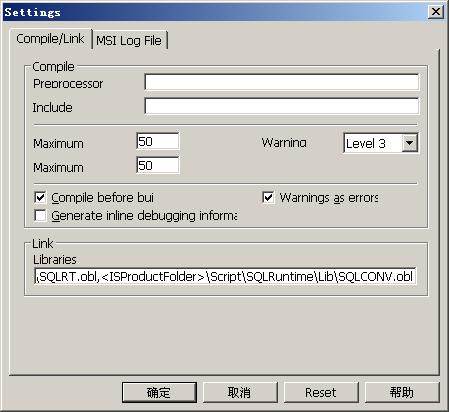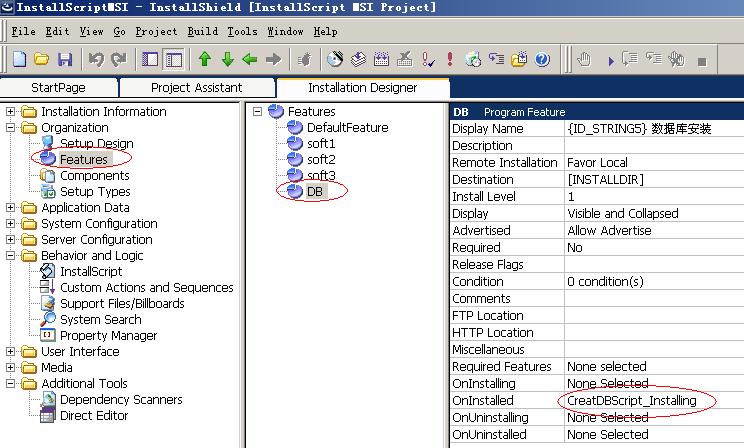由于安装时用户可以选择安装软件1、安装软件2、安装软件3、安装数据库等多个选项,用户可以选择是否安装数据,而且只有选择安装数据库才进行数据库的安装。
这样要在安装包中自己来对数据库的安装进行定制,而installshield 2008中默认的 数据库安装方式是在一开始就运行的。不能选择不安装。
在网上查了许多资料,参考http://community.acresso.com/showthread.php?t=156641以及网上其他的资料。最终解决了此问题。
我的工程环境为:
Installshield2008
工程为Installscript MSI Project.(选择installScript工程在编译时出现了函数未定义的错误,有时间再做installscript工程的。)
操作系统为windows2003 server.
1、加.obl文件到工程。
在build菜单->settings->Compile/Link选项卡中.
如下图
在link libraries中加入以下两行(如果他们不存在),以英文逗号分隔。
- <ISProductFolder>/Script/SQLRuntime/Lib/SQLRT.obl
- <ISProductFolder>/Script/SQLRuntime/Lib/SQLCONV.obl
2、加入相应的dll到Binary Table,在Additional Tools->Direct editor->Binary
在第一个输入框中输入名字SQLRT.DLL,在第二个输入框中,点浏览找到<ProgramFiles>/InstallShieldX/Redist/Compressed Files/Language Independent/Intel 32/SQLRT.dll.点确定dll被加入到表中。
同样在新的一行第一个输入框中ISSQLSRV.DLL,在第二个输入框中,点浏览找到
<ProgramFiles>/InstallShieldX/Redist/Language Independent/i386/ISSQLSrv.dll,点确定dll被加入到表中。
如下图
3、写脚本。
//===========================================================================
//
// File Name: Setup.rul
//
// Description: Blank setup main script file
//
// Comments: Blank setup is an empty setup project. If you want to
// create a new project via. step-by step instructions use the
// Project Assistant.
//
//===========================================================================
// Included header files ----------------------------------------------------
#include "ifx.h"
export prototype CreatDBScript_Installing();
prototype CreateDataBase(STRING,STRING,STRING,BOOL);
//---------------------------------------------------------------------------
// The Installing event is sent after the feature CreatDBScript
// is installed.
//---------------------------------------------------------------------------
function CreatDBScript_Installing()
string sMessage,sDLL;
string szConnection, szServer, szUser, szPassword, szDB, sTemp[MAX_PATH];
number nResult, nSize, nCount,nBtn;
BOOL bWinLogin, bNext;
LIST listConnections;
begin
sDLL = SUPPORTDIR ^ "SQLRT.DLL";
nResult = StreamFileFromBinary( ISMSI_HANDLE, "SQLRT.DLL", sDLL );
UseDLL(sDLL);
//First initialize SQL Server runtime
SQLRTInitialize2();
// Suppress ISSQLSRV.DLL to show a connection error message.
MsiSetProperty( ISMSI_HANDLE, "IS_SQLSERVER_CA_SILENT", "1" );
//Get the names of all the necessary connections
listConnections = SQLRTGetConnections();
ListGetFirstString (listConnections, szConnection);
nCount = 0;
//determine if NEXT or BACK will be returned
//if there are no connections to make
if( nBtn != BACK ) then
bNext = TRUE;
else
bNext = FALSE;
//start at end if going BACK
while (ISERR_SUCCESS = ListGetNextString( listConnections, szConnection ) );
nCount++;
endwhile;
endif;
sDLL = SUPPORTDIR ^ "ISSQLSRV.DLL";
nResult = StreamFileFromBinary( ISMSI_HANDLE, "ISSQLSRV.DLL", sDLL );
UseDLL(sDLL);
// Login for each connection
while (nResult = ISERR_SUCCESS)
//Get Default values for connection
SQLRTGetConnectionInfo( szConnection, szServer, szDB, szUser, szPassword );
bWinLogin = SQLRTGetConnectionAuthentication( szConnection );
// Display login dialog (without connection name)
// COMMENT OUT TO SWAP DIALOGS
nResult = SQLServerSelectLogin2( szConnection, szServer, szUser, szPassword, bWinLogin, szDB, FALSE, TRUE );
// Display login dialog (with connection name)
// UNCOMMENT TO SWAP DIALOGS
// nResult = SQLServerSelectLogin2( szConnection, szServer, szUser, szPassword, bWinLogin, szDB, TRUE, TRUE );
if( nResult = NEXT ) then
//store data in case we need it again
SQLRTPutConnectionInfo2( szConnection, szServer, szDB, szUser, szPassword );
SQLRTPutConnectionAuthentication( szConnection, bWinLogin );
//test connection
nResult = SQLRTTestConnection2( szConnection, szServer, szDB, szUser, szPassword, bWinLogin );
nSize = MAX_PATH;
MsiGetProperty( ISMSI_HANDLE, "IS_SQLSERVER_STATUS", sTemp, nSize );
if( sTemp != "0" ) then
nSize = _MAX_PATH;
MsiGetProperty( ISMSI_HANDLE, "IS_SQLSERVER_STATUS_ERROR", sMessage, nSize );
if( nSize = 0 ) then
Sprintf(sMessage, SdLoadString( IDS_IFX_SQL_ERROR_LOGIN_FAILED ), szConnection, SdLoadString( ISCRIPT_E_UNKNOWN_ERROR_DESC ));
endif;
MessageBox( sMessage, MB_OK );
//Show same login dialog again
nResult = ListCurrentString(listConnections, szConnection);
else //SUCCESS
//Move on to next connection
nCount++;
bNext = TRUE;
nResult = ListGetNextString(listConnections, szConnection);
CreateDataBase( szServer, szUser, szPassword, bWinLogin ) ;
endif;
else
//BACK
nCount--;
bNext = FALSE;
nResult = ListSetIndex( listConnections, nCount );
ListCurrentString( listConnections, szConnection );
endif;
endwhile;
if( bNext ) then
return NEXT;
else
return BACK;
endif;
end;
function number CreateDataBase(svSQLsvr,svSQLusr,svSQLpwd,bWindowsLogin)
STRING szCmdLine,szWaitTxt;
begin
szWaitTxt=" 正在创建所需数据库.";
SdShowMsg (szWaitTxt, TRUE);
Delay(2);
if(bWindowsLogin) then
szCmdLine = "/E /S "+svSQLsvr+" /Q /"EXEC sp_attach_db @dbname = N'dlbj',@filename1 = N'"+TARGETDIR ^"mydb.MDF',@filename2 = N'"+TARGETDIR ^"dlbj_web_log.LDF'/"";
else
szCmdLine = "/U "+svSQLusr+" /P "+svSQLpwd+" /S "+svSQLsvr+" /Q /"EXEC sp_attach_db @dbname = N'dlbj',@filename1 = N'"+TARGETDIR ^"dlbj_web.MDF',@filename2 = N'"+TARGETDIR ^"mydb_log.LDF'/"";
endif;
//szCmdLine = "/U "+svSQLusr+" /P "+svSQLpwd+" /S "+svSQLsvr+" /Q /"EXEC sp_attach_db @dbname = N'dlbj',@filename1 = N'"+TARGETDIR ^"dlbj_web.MDF',@filename2 = N'"+TARGETDIR ^"dlbmydb_log.LDF'/"";
if (LaunchAppAndWait("osql.exe", szCmdLine,WAIT) < 0) then
MessageBox ("数据库创建失败!请确您的系统中已安装 Microsoft SQL Server 2000. 如仍无法解决,请联系系统供应商!",SEVERE);
endif;
SdShowMsg (szWaitTxt, FALSE);
szWaitTxt=" 正在优化系统数据库.";
SdShowMsg (szWaitTxt, TRUE);
Delay(2);
szCmdLine = "/U "+svSQLusr+" /P "+svSQLpwd+" /S "+svSQLsvr+" /Q /"use dlbj ; exec sp_updatestats/"";
if (LaunchAppAndWait("osql.exe", szCmdLine,WAIT) < 0) then
MessageBox ("数据库优化失败!您可以在 sql查询分析器中执行 use dlbj ; exec sp_updatestats 完成!",SEVERE);
endif;
SdShowMsg (szWaitTxt, FALSE);
return 0;
end;
4、设置数据库安装位置
在Organization中Features加入soft1,soft2,soft3,DB等。现在要把数据库安装与DB相关联,只有用户选择数据库安装才进行数据库的安装。
在右侧的 DB Program Feature中的Display name中输入相应的安装说明,如数据库安装.
在OnInStalled中,在下拉框中选择CreatDBScript_Installing,如果没有出现在这,看函数前是否加了export关键字。
如下图
这样就完成了。
另外也参考网上http://www.cnblogs.com/culturenet/archive/2006/12/19/596930.html。
以及installshield自己生成的代码。
在以后的安装实践中,发现会出现对话框不退出的情况,没有好的办法解决。
只好把它又在原来地方,用判断来确定是否出现对话框了。


























 129
129

 被折叠的 条评论
为什么被折叠?
被折叠的 条评论
为什么被折叠?










